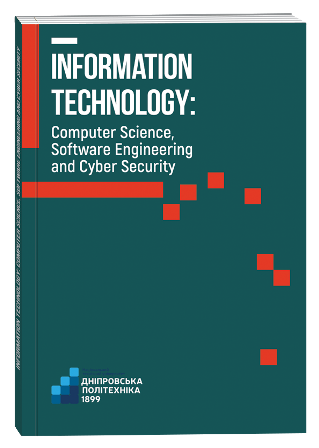ШТУЧНИЙ ІНТЕЛЕКТ НА ОСНОВІ TENSORFLOW В НАВЧАЛЬНОМУ ПРОЦЕСІ
DOI:
https://doi.org/10.32782/IT/2021-1-5Ключові слова:
бібліотека TensorFlow, штучний інтелект, інтелектні програмні продукти, нейронні мережі.Анотація
У цій статті обговорюється проблема використання бібліотеки TensorFlow в навчальних цілях. Основна ідея роботи – проаналізувати рішення інтелектних програмних продуктів для студентів, які навчаються на основі фреймворку TensorFlow. Описано технологічні передумови; переглянуті основи систем інтелектних програмних засобів на основі TensorFlow. У цій статті ми спочатку проілюструємо сучасний рівень застосування TensorFlow до освітніх проблем. У статті аналізуються існуючі сфери застосування програмних продуктів на основі бібліотеки TensorFlow. На закінчення проводиться класифікація сфер застосування програмного забезпечення, яка базується на TensorFlow. Методологія вирішення цієї проблеми полягає у визначенні основних типів проблем штучного інтелекту на основі TensorFlow та описі основних напрямів рішень на основі TensorFlow в навчальному процесі. Наукова новизна. У статті показано, що використання бібліотеки TensorFlow в навчальних цілях, яка базується на векторах і матрицях математики та глибокого навчання, дозволяє реалізувати принципи штучних нейронних мереж з методологією штучного інтелекту.
Посилання
M. Alomran and D. Chai. Automated scoring system for multiple choice test with quick feedback. International Journal of Information and Education Technology, 8: 538–545, 2018.
Mi Chunqiao, Peng Xiaoning, and Deng Qingyou. An artificial neural network approach to student study failure risk early warning prediction based on tensorflow. 2 2018. doi: 10.1007/978-3-319-73317-3_38.
Tenzin Doleck, David John Lemay, Ram B. Basnet, and Paul Bazelais. Predictive analytics in education: a comparison of deep learning frameworks. Education and Information Technologies, 25(3):1951–1963, May 2020. doi:10.1007/s10639-019-10068-4.
Jaehyoun Kim Eunsill Jang. Deep learning: The impact on future elearning. Journal of Internet Computing and Services, 20(6):167–177, 12 2019. doi:10.7472/jksii.2019.20.6.167.
Wilton Fok, Y.S. He, H.H. Yeung, K.Y. Law, KH Cheung, YY Ai, and Prajna Ho. Prediction model for students’ future development by deep learning and tensorflow artificial intelligence engine. pages 103–106, 05 2018. doi:10.1109/INFOMAN.2018.8392818.
Ashok K. Goel and Lalith Polepeddi. Jill watson: A virtual teaching assistant for online education. 2016.
Song Guo, Deze Zeng, and Shifu Dong. Pedagogical data analysis via federated learning toward education 4.0. 4:56–65, 12 2020. doi:10.11648/j.ajeit.20200402.13.
Wen-yuan Hao, Jae-woong Kim, and Jun He. The application of tensorflow facial recognition technology in education assistant system. pages 309–312, 08 2019. doi:10.35745/ecei2019v2.080.
Sepp Hochreiter and Jurgen Schmidhuber. Long Short-Term Memory. Neural Computation, 9(8):1735–1780, 11 1997. arXiv:https://direct.mit.edu/neco/article-pdf/9/8/1735/813796/neco.1997.9.8.1735. pdf, doi:10.1162/neco.1997.9.8.1735.
HolonIQ. 2019 artificial intelligence and global education report, 2019. https://www.holoniq.com/wp-content/ uploads/2019/05/HolonIQ-Extract-AI-and-Global-Education-May-2019.pdf, Last accessed on 2021-04-13.
Amy Hoover, Adam Spryszynski, and Michael Halper. Deep learning in the it curriculum. pages 49–54, 09 2019. doi:10.1145/3349266.3351406.
Zeki Küükkara and A. E. Tümer. An image processing oriented optical mark recognition and evaluation system. International Journal of Applied Mathematics, Electronics and Computers, 6:59–64, 2018.
Quoc Tuan Le, Antoshchuk Svitlana, Thi Khanh Tien Nguyen, The Vinh Tran, and Nhan Cach Dang. Automated student attendance monitoring system in classroom based on convolutional neural networks. Applied Aspects of Information Technology, 3(3):179–190, 2020. doi:10.15276/aait.03.2020.6.
Biswas M. Chatbot with TensorFlow. In: Beginning AI Bot Frameworks. 2018. doi:10.1007/978-1- 4842-3754-0_5.
James Manyika, Susan Lund, Michael Chui, and et al. Jobs lost, jobs gained: What the future of work will mean for jobs, skills, and wages, 2017. URL: https://apo.org.au/node/199751.
Angelo Menezes, Joao Sa, Eduardo Llapa, and Carlos Estombelo-Montesco. Automatic attendance management system based on deep one-shot learning. Pages 137–142, 07 2020. doi:10.1109/IWSSIP48289.2020.9145230.
Anandhavalli Muniasamy and Areej Alasiry. Deep learning: The impact on future elearning. International Journal of Emerging Technologies in Learning (iJET), 15:188, 01 2020. doi: 10.3991/ijet.v15i01.11435.
Andres Pedreno Munoz. Lola, the intelligent chatbot that triumphs among students, 2019. https:// spainsnews.com/lola-the-intelligent-chatbot-that-triumphs-among-students-innovation/, Last accessed on 2021-04-13.
Robert Murphy. Artificial Intelligence Applications to Support K-12 Teachers and Teaching: A Review of Promising Applications, Challenges, and Risks. 01 2019. doi:10.7249/PE315.
Emilien Nizon. 1,200+ business school students used my chatbot – ed – in class. here is what you should know, 2020. https://www.linkedin.com/pulse/1200-business-school-students-used-my-chatbot-edclass- nizon/, Last accessed on 2021-04-13.
Bogdan Oancea, Raluca Dragoescu, and Stefan Ciucu. Predicting students results in higher education using neural networks. 04 2013.
F. Pedró, Miguel Subosa, A. Rivas, and P. Valverde. Artificial intelligence in education : challenges and opportunities for sustainable development. 2019.
Carlo Perrotta and Neil Selwyn. Deep learning goes to school: toward a relational understanding of ai in education. Learning, Media and Technology, 45(3):251–269, 2020. arXiv:https: //doi.org/10.1080/17439884. 2020.1686017, doi:10.1080/17439884.2020.1686017.
Rakesh S, Kailash Atal, and Ashish Arora. Cost effective optical mark reader. International Journal of Computer Science and Artificial Intelligence, 3:44–49, 06 2013. doi:10.5963/IJCSAI0302002.
Hung-Yue Suen, Kuo-En Hung, and Chien-Liang Lin. Tensorflow-based automatic personality recognition used in asynchronous video interviews. IEEE Access, PP:1–1, 03 2019. doi:10.1109/ACCESS.2019.2902863.
Anjana Tiha. Intelligent Chatbot using Deep Learning. PhD thesis, 04 2018. doi:10.13140/ RG.2.2.14006.75841.
Shuo-Chang Tsai, Cheng-Huan Chen, Yi-Tzone Shiao, Jin-Shuei Ciou, and Trong-Neng Wu. Precision education with statistical learning and deep learning: A case study in taiwan. 17:12,04 2020. doi:10.1186/ s41239-020-00186-2.
Tyler Vigen. Spurious correlations, 2020. https://www.tylervigen.com/spurious-correlations/, Last accessed on 2021-04-13.
Dan Wang, Rong Fu, and Zuying Luo. Classroom attendance auto-management based on deep learning. In Proceedings of the 2017 2nd International Conference on Education, Sports, Arts and Management Engineering (ICESAME 2017), pages 1523–1528. Atlantis Press, 2017/06. URL: https://doi.org/10.2991/ icesame-17.2017.327







